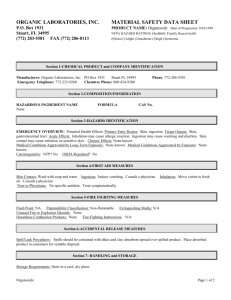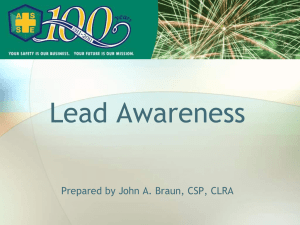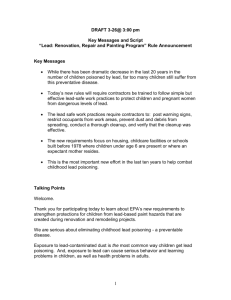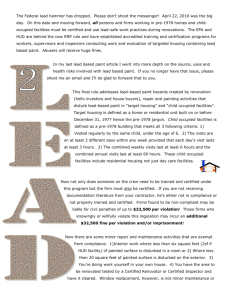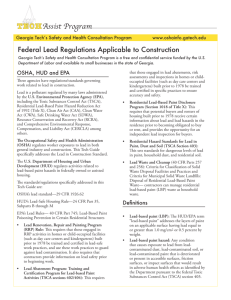A Discussion of OSHA Requirements for Disturbing Paint with Lead
advertisement
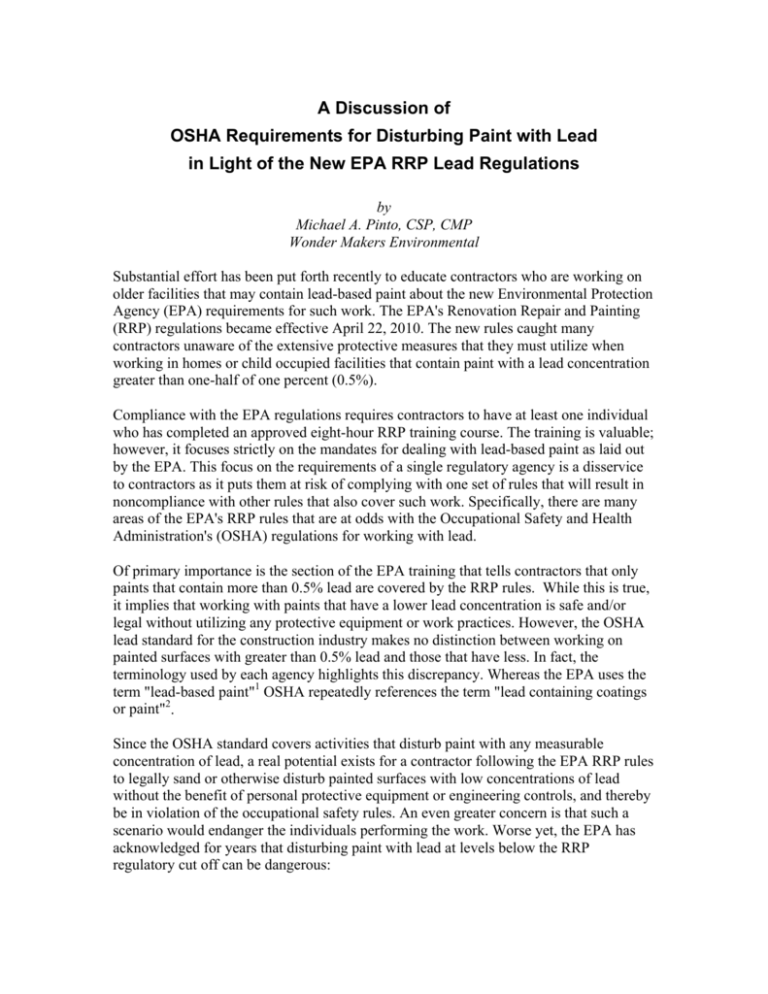
A Discussion of OSHA Requirements for Disturbing Paint with Lead in Light of the New EPA RRP Lead Regulations by Michael A. Pinto, CSP, CMP Wonder Makers Environmental Substantial effort has been put forth recently to educate contractors who are working on older facilities that may contain lead-based paint about the new Environmental Protection Agency (EPA) requirements for such work. The EPA's Renovation Repair and Painting (RRP) regulations became effective April 22, 2010. The new rules caught many contractors unaware of the extensive protective measures that they must utilize when working in homes or child occupied facilities that contain paint with a lead concentration greater than one-half of one percent (0.5%). Compliance with the EPA regulations requires contractors to have at least one individual who has completed an approved eight-hour RRP training course. The training is valuable; however, it focuses strictly on the mandates for dealing with lead-based paint as laid out by the EPA. This focus on the requirements of a single regulatory agency is a disservice to contractors as it puts them at risk of complying with one set of rules that will result in noncompliance with other rules that also cover such work. Specifically, there are many areas of the EPA's RRP rules that are at odds with the Occupational Safety and Health Administration's (OSHA) regulations for working with lead. Of primary importance is the section of the EPA training that tells contractors that only paints that contain more than 0.5% lead are covered by the RRP rules. While this is true, it implies that working with paints that have a lower lead concentration is safe and/or legal without utilizing any protective equipment or work practices. However, the OSHA lead standard for the construction industry makes no distinction between working on painted surfaces with greater than 0.5% lead and those that have less. In fact, the terminology used by each agency highlights this discrepancy. Whereas the EPA uses the term "lead-based paint"1 OSHA repeatedly references the term "lead containing coatings or paint"2. Since the OSHA standard covers activities that disturb paint with any measurable concentration of lead, a real potential exists for a contractor following the EPA RRP rules to legally sand or otherwise disturb painted surfaces with low concentrations of lead without the benefit of personal protective equipment or engineering controls, and thereby be in violation of the occupational safety rules. An even greater concern is that such a scenario would endanger the individuals performing the work. Worse yet, the EPA has acknowledged for years that disturbing paint with lead at levels below the RRP regulatory cut off can be dangerous: Lead can still be present in paint which is not classified as “lead-based.” This would occur when the paint has a lower amount of lead than the federal government regulates. If lead is present in the paint, lead dust can be released when the paint deteriorates, or is disturbed during remodeling, renovation, sanding, or some maintenance work that breaks the surface of the paint. 3 This health risk is so great that OSHA requires construction contractors to identify all materials that contain lead and forces them to conduct air monitoring if their work activities are going to disturb that material. This initial air monitoring is conducted on workers disturbing lead-containing paint to establish exposure levels to lead for those workers. The recorded levels are then compared to two different airborne concentrations listed in the OSHA standard: the action limit (AL) and the permissible exposure limit (PEL). Currently, the action limit is set at 30 micrograms of lead per cubic meter of air (µg/m3) and the permissible exposure limit is 50 µg/m3. These limits are easily exceeded, even when the paint being disturbed has a lead concentration less than the EPA limit of 0.5%. Illustration 1 is a graph of typical airborne lead levels for common work activities when the paint film that is being damaged contains approximately 0.3% lead—a concentration low enough that the material is exempted from RRP requirements. Airborne concentrations greater than OSHA limits trigger a variety of contractor requirements that are not even mentioned in the standard EPA RRP training classes. Not only is ignorance of the OSHA requirements no excuse for contractors to avoid citations, inability to conduct air monitoring is not accepted as an excuse either. If personal monitoring of activities disturbing paint with lead is not conducted by the contractor then OSHA mandates that “the employer shall treat the employee as if the employee were exposed above the PEL”.4 The OSHA standard then gets even more specific. Where surfaces with paint containing lead are going to be disturbed and no personal air monitoring data related to specific tasks is provided by the contractor or an industry association, the regulations specify the expected airborne concentrations of lead for a wide range of work activities. For example, manual demolition of painted surfaces (such as drywall removal), hand scraping, hand sanding, and use of a power tool with a dust collection system must be treated as if the exposure levels were between 50 and 500 µg/m3. This means that most contractors that disturb paint with any level of lead are required to move substantially beyond the minimum requirements of the EPA's Renovation, Repair and Painting (RRP) Rule. In essence, all such work should look like an asbestos or mold remediation project with negative pressure enclosures and a minimum one-stage decontamination chamber. The air monitoring results are also the information that forms the foundation for a number of other important requirements under the OSHA rules. Based on the exposure levels measured during the initial monitoring, determinations must be made as to the training requirements, work practices, and engineering controls that will be used by those workers. To provide an example of how much critical information is left out of the EPA RRP training, the following is a list of OSHA requirements for jobs impacting lead paints, based on exposure monitoring levels: • For work where exposure to lead is found to be below 30 µg/m3 of airborne lead (exterior demolition work usually falls into this category): General housekeeping Hand and face washing “Right to Know” training for lead • For work where exposure to lead is found to exceed 30 µg/m3 but is below 50 µg/m3 of airborne lead: All of the above requirements Lead awareness training (2 hours) Initial blood testing on the first day lead levels are found to be above 30 µg/m3 Medical surveillance if exposed above 30 µg/m3 for more than 30 days per year • For work where exposure to lead is found to exceed 50 µg/m3 of airborne lead: All of the above requirements Respirators Engineering controls including HEPA vacuums, negative air machines, and wet methods Personal protective equipment Regulated areas, signs, and labels Decontamination facility The truly disheartening part of all of this confusion, overlap, and narrow presentation of important safety and health information is that at least one of the agencies involved in regulating lead recognized years ago that better coordination was needed to help contractors deal with this dangerous substance. In 2007 OSHA did a review of its lead standard and the evaluation resulted in two important recommendations. Unfortunately, there was not enough coordination between various entities to act on the following suggestion: OSHA will consult with EPA and HUD to determine the value of a unified training curriculum and whether a course can be developed to meet the requirements of all three agencies. OSHA also will attempt to develop interpretations for its initial assessment requirements [29 CFR 1926.62(d)], in order to integrate them better with HUD and EPA requirements, reduce duplication, and make better use of historical data; these interpretations should help reduce costs and simplify the standard's requirements for small businesses. 5 As a result, the narrow training presented in the majority of EPA RRP classes puts contractors at great risk of both civil and regulatory liability rather than protecting them! 1 According to page 9 of the publication Testing Your Home for Lead (EPA 747-K-00-001, July 2000), in order for it to be considered lead-based paint, the paint must have greater than or equal to 0.5% lead. 2 For example, see the sections of the federal standard for lead in the construction industry identified as 29 CFR 1926.62(d)(2)(i) and 29 CFR 1926.62(d)(2)(iii)(B). 3 Testing Your Home for Lead, page 9, EPA 747-K-00-001, July 2000. 4 29 CFR 1926.62(d)(2)(i). 5 Excerpted from Regulatory Review of 29 CFR 1926.62; Lead in Construction Pursuant to Section 610 of the Regulatory Flexibility Act and Section 5 of Executive Order 12866 Occupational Safety and Health Administration, Directorate of Evaluation and Analysis, Office of Evaluations and Audit Analysis; September 2007. Illustration 1: Typical Airborne Lead Levels for Common Work Activities Micrograms/Meter 3 600 500 400 300 200 100 *50 0 Hand Sanding Power Sanding Interior Demolition Traditional Work Practices * OSHA Permissible Exposure Limit (PEL) = 50 µg/m3
![[Agency] recognizes the hazards of lead](http://s3.studylib.net/store/data/007301017_1-adfa0391c2b089b3fd379ee34c4ce940-300x300.png)
